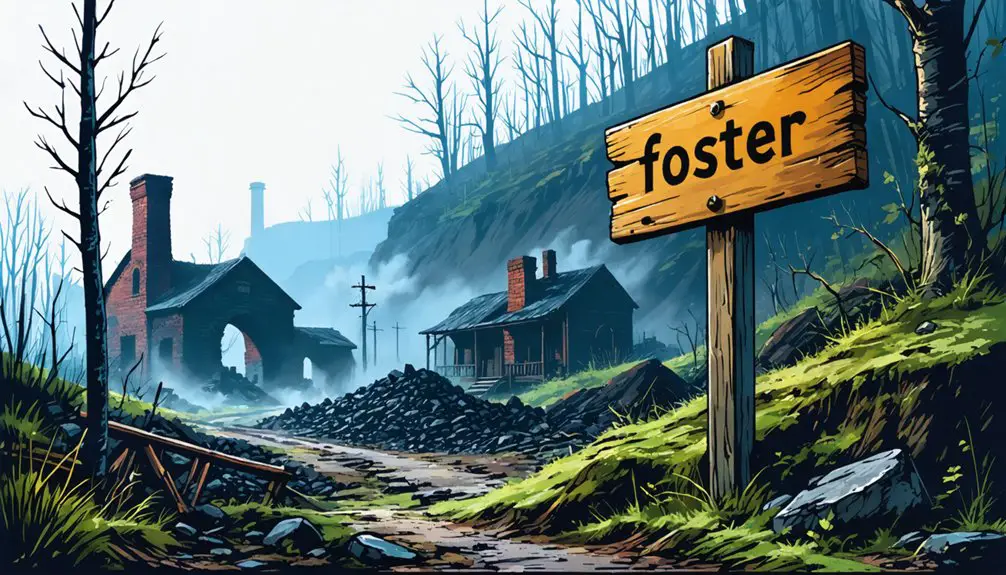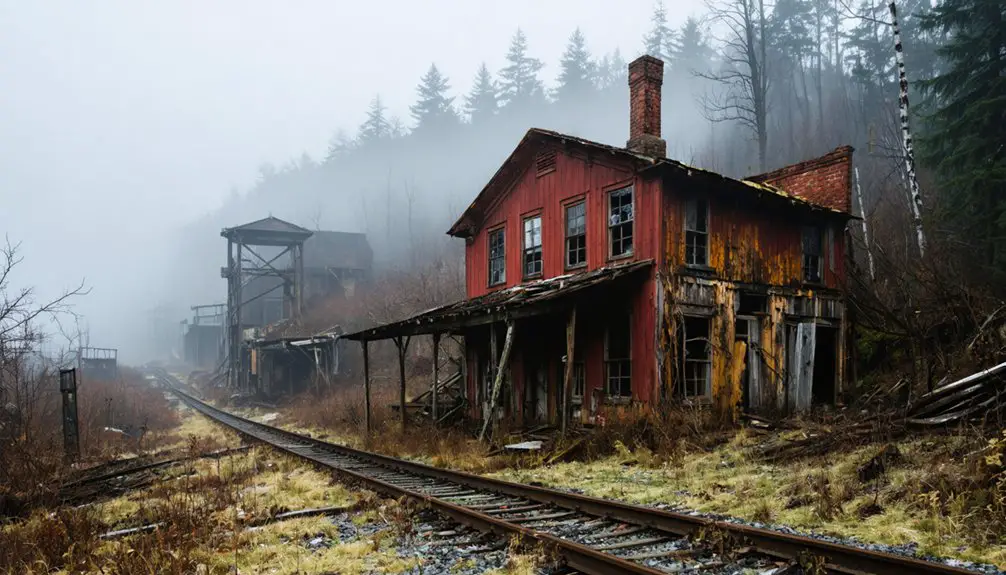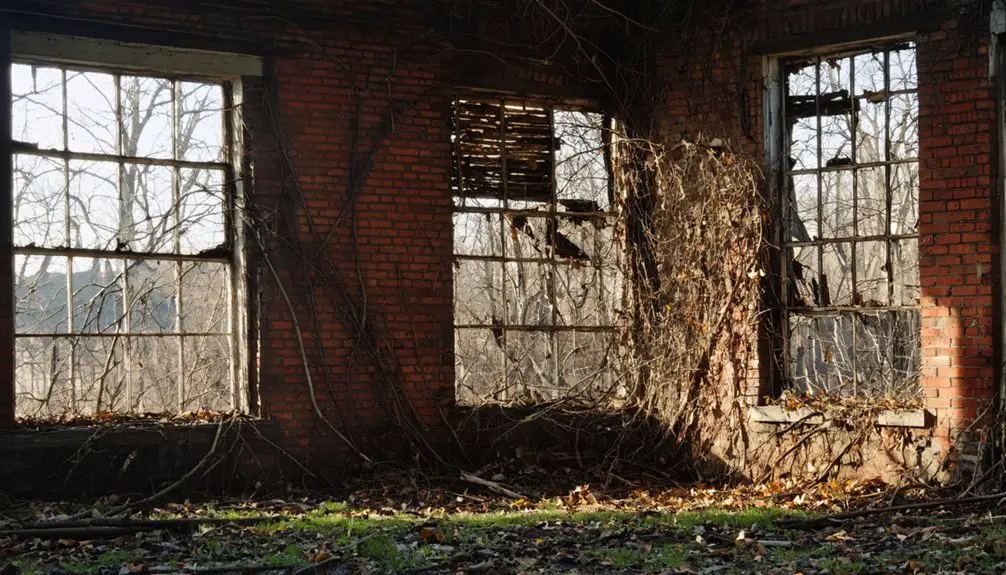You’ll find Foster Township, Pennsylvania haunted by its coal mining past, where Asa Lansford Foster transformed a humble logging settlement into a thriving anthracite empire in the 1850s. The area’s abandoned mines, scattered remnants of patch towns, and the historic Assumption of the Blessed Virgin Mary Church tell stories of immigrant miners and their families. Steam still rises from underground mine fires, while metal venting tubes and crumbling foundations offer glimpses into this once-prosperous community’s fascinating history.
Key Takeaways
- Foster Township transformed from a thriving coal mining community to a ghost town following the decline of anthracite mining operations.
- Underground mine fires, visible through steam vents and ground cracks, contribute to the area’s current abandoned state.
- The closure of Foster’s coal operations in the mid-1900s led to mass exodus, leaving behind empty buildings and mining infrastructure.
- The Assumption of the Blessed Virgin Mary Church remains one of few active structures amid the largely deserted township.
- Former “patch towns” that once housed immigrant miners now stand abandoned, serving as remnants of the area’s coal mining heritage.
The Early Days of Shingletown Settlement
When John Lines first settled in what would become Foster Township in 1824, the densely forested area known as Shingletown emerged as a rustic logging community in northeastern Pennsylvania.
You’ll find that early settlers made their living primarily through the production of wooden shingles, which they’d trade in nearby towns like White Haven and Hazleton for essential supplies including whiskey, port, and tobacco. Much like other place name disambiguation cases of the era, several other settlements in Pennsylvania also carried variations of the Shingletown name.
The rural economy thrived on the abundant forests owned by Tench Coxe, whose estate would later play a significant role in the area’s development. The discovery of coal in 1853 by four prospectors would forever change the community’s trajectory.
Rise of the Anthracite Coal Empire
You’ll find that Shingletown’s quiet existence as a lumber settlement changed dramatically in 1853 when prospectors unearthed rich anthracite veins, prompting the swift formation of Sharpe, Leisenring, and Company.
The company’s innovative approach to mining these high-carbon deposits included securing a substantial 20-year lease on 1,500 acres from the Tench Coxe Estate, establishing one of Foster Township’s first major coal operations. The area was originally known as Shingletown due to its inhabitants’ practice of making shingles from surrounding woodlands.
The influx of mining wealth transformed the local economy, as immigrant laborers flocked to the area and company-built facilities replaced the simple wooden structures of the original settlement. The discovery of an effective iron grate system in 1808 had already proven that anthracite could be reliably ignited for industrial use, paving the way for the region’s mining boom.
Coal Discovery Changes Everything
The discovery of rich anthracite coal veins in Foster Township during 1853 dramatically transformed Shingletown from a quiet logging settlement into the bustling Eckley Miners’ Village. Four prospectors’ findings sparked an economic boom that would forever change the region’s destiny.
Within just a year, Sharpe, Leisenring, and Company secured a 20-year lease from Judge Charles Coxe to mine 1,500 acres. You’d hardly recognize the former wilderness as it quickly gave way to industrial progress. The area had previously been a rural community where settlers made their living by creating shingles from woodlands.
The company invested $7,000 in a sawmill and mining works, and by 1855, they were shipping 2,000 tons of coal. Under the leadership of Asa L. Foster and his partners, the area evolved from a simple shingle-making community into a thriving coal empire that helped power America’s industrial revolution. The Susquehanna & Lehigh Railroad played a vital role in transporting the region’s coal to distant markets.
Innovative Mining Methods Emerge
Mining success in Foster Township demanded more than just finding coal – it required revolutionary extraction and transportation methods.
You’ll find that Asa Lansford Foster pioneered innovative techniques that transformed the region’s mining technology, implementing strategic infrastructure that connected mines to essential transportation routes.
- Four-mile railroad systems replaced inefficient mule transport
- Steam-powered equipment enhanced deep mining capabilities
- Advanced tunnel construction allowed better access to coal veins
- Geological surveying led to more precise extraction methods
In the 1830s and 1840s, Foster’s engineering expertise revolutionized how anthracite was mined and moved.
His improvements to infrastructure included sophisticated tunnel networks and inclined planes that maximized efficiency.
These developments in the Panther Valley region didn’t just change mining – they established an entire transport-linked industry that would define northeastern Pennsylvania’s industrial landscape.
The Buck Mountain Coal Company he founded became a model for efficient mining operations in the region.
The discovery of coal by four prospectors in 1853 accelerated the township’s transformation from a rural community to a thriving mining center.
Wealth Transforms Local Economy
When vast anthracite coal veins were discovered in Shingletown (later Eckley) in 1853, Foster Township’s fortunes changed dramatically. The economic transformation began as Sharpe, Leisenring and Company quickly leased 1,500 acres from the Tench Coxe Estate, shifting the region from logging to coal mining.
Under the influence of pioneering entrepreneur Asa Lansford Foster, the area’s potential released unprecedented wealth. The local inhabitants, who once made their living through trading wooden shingles, found new opportunities in the burgeoning coal industry. Many Irish and Welsh miners arrived seeking work in the expanding operations.
You’d have witnessed profound community dynamics as company towns emerged to house immigrant workers, while new transportation networks connected Foster Township to industrial centers. The Lehigh River and expanding railroads carried the prized high-carbon anthracite to hungry markets.
Yet this coal-driven prosperity came at a price – creating boom-bust cycles that affected workers’ lives, while company control extended into housing, stores, and every aspect of daily life.
Life in a Thriving Mining Community
As Pennsylvania’s anthracite coal industry boomed in the late 1800s, Foster’s company-owned “patch towns” emerged as tightly controlled communities where immigrant miners and their families carved out modest lives amid the demanding rhythms of coal extraction.
Despite the coal companies’ iron grip on housing, jobs, and commerce, strong community bonds formed among diverse European immigrant cultures who shared the daily struggles of mining life.
- You’d find simple workers’ houses clustered on hillsides near the mines, with churches and company stores serving as social hubs.
- Your workday would revolve around grueling mine shifts, paid by the ton and often in company scrip.
- You’d rely on neighbors during strikes, accidents, and hardships, building networks of mutual support.
- Your cultural identity would thrive through church gatherings, festivals, and traditions from the old country.
The Legacy of Asa L. Foster

While you’ll find Asa L. Foster‘s name throughout Pennsylvania’s anthracite region today, his influence began in 1818 when he arrived from Massachusetts to pioneer the area’s coal mining industry.
As superintendent of Buck Mountain Coal Company and a skilled mining engineer, he constructed essential infrastructure including tunnels, wharves, and a four-mile railroad that connected mines to canal systems near Rockport.
Foster’s lasting impact on northeastern Pennsylvania is particularly evident in Foster Township, which was named after him in 1855 and stands as a monument to his role in transforming the region from rural woodland into a thriving coal mining hub.
Pioneer of Coal Mining
Despite his humble beginnings with only a common school education, Asa Lansford Foster emerged as a pioneering force in Pennsylvania’s anthracite coal industry after arriving from Massachusetts in 1818.
Foster’s expertise in coal geology and mining engineering revolutionized the region’s development, particularly through his work with the Lehigh Coal Company and later founding of the Buck Mountain Coal Company.
- Developed innovative mining techniques and infrastructure, including essential railroad connections and wharves
- Drove the first mining tunnels in Panther Creek Valley, expanding access to rich coal seams
- Advanced anthracite-burning stove technology, showing his commitment to coal innovations
- Purchased and developed Upper Lehigh land containing multiple valuable coal seams
You’ll find his influence throughout northeastern Pennsylvania’s mining history, from early vertical shafts to extensive resource development strategies that shaped the anthracite basin’s expansion.
Lasting Regional Impact
The enduring legacy of Asa L. Foster lives on throughout Pennsylvania’s Coal Region, where you’ll find his influence in both place names and community resilience.
Two locations – Foster Township in Luzerne County and the borough of Lansford in Carbon County – bear his name as evidence of his impact. His grave monument in Mauch Chunk (now Jim Thorpe) stands as a focal point for historical preservation efforts.
Beyond geographical markers, Foster’s contributions shaped the region’s development through innovative mining techniques and transportation solutions.
You can trace his influence in the four-mile railroad he built and the mining tunnels he pioneered in Panther Creek Valley. His ethical business practices and charitable nature fostered social stability, while his geological expertise and industrial leadership helped establish the foundation for the area’s economic growth.
When the Coal Mines Went Silent
Once bustling with mining activity, Foster’s coal operations began their irreversible decline in the mid-1900s as America’s energy needs shifted away from anthracite coal.
These economic shifts hit the community hard, yet you’ll find stories of community resilience throughout Foster Township’s transformation from industrial powerhouse to historical preservation site.
- The 1915 Foster Tunnel explosion marked the beginning of troubling times for local mining operations.
- Rising operational costs and depleting coal veins made mining increasingly unprofitable.
- Competition from oil and natural gas drastically reduced demand for coal.
- Labor disputes and lack of modernization accelerated the mines’ closure.
As miners and their families left seeking work elsewhere, Foster’s company stores and patch towns lost their economic foundation.
Traces of Yesterday: What Remains Today

Walking through Foster Township today, you’ll find scattered remnants of its coal mining past amid quiet streets and overgrown lots.
Ghost town remnants include the still-standing Assumption of the Blessed Virgin Mary Church, where weekly services continue despite the area’s abandonment.
You’ll notice metal venting tubes dotting the landscape, releasing heat and gases from the underground fires that span roughly 400 acres.
The infamous “Graffiti Highway” – a section of abandoned Route 61 – stood as a symbol of urban artistic expression until its closure in 2020.
The site’s cultural significance extends beyond its physical remains, having inspired the horror franchise Silent Hill.
Despite official warnings against visitors, the township’s eerie atmosphere and visible steam rising from ground cracks continue to draw curious explorers.
Frequently Asked Questions
What Dangerous Wildlife Currently Inhabits the Abandoned Areas of Foster Township?
You’ll encounter black bears, venomous snakes, territorial coyotes, and black widow spiders in Foster Township’s abandoned habitats, plus disease-carrying ticks and mosquitoes threatening your exploration of dangerous animals’ territories.
Are There Any Documented Paranormal Activities in Foster’s Abandoned Mining Structures?
Ever wonder what lurks in those old mines? You’ll find documented ghost sightings throughout Foster’s abandoned structures, with investigators reporting apparitions, unexplained voices, and cold spots tied to its haunted history of mining disasters.
Can Visitors Legally Explore and Metal Detect in Foster’s Ghost Town?
You’ll need exploration permits and landowner permission to legally visit Foster’s sites. Metal detecting faces strict legal restrictions, so obtain proper authorization to avoid trespassing charges in Luzerne County.
What Valuable Artifacts Have Been Discovered in Foster’s Ruins?
You’ll find historic relics like coal processing tools, abandoned mining equipment, bed springs, mattress cushions, and industrial pipe fittings scattered throughout the ruins, though most valuable items were removed long ago.
Does Foster Township Maintain Any Active Cemeteries From Its Mining Days?
Like footprints in stone, you’ll find Coal Hill Cemetery stands as Foster Township’s most prominent mining relic from 1883, though records don’t confirm if it’s actively maintained by township authorities today.
References
- https://fostertownship.org/LEARN ABOUT…-304.htm
- https://www.youtube.com/watch?v=HHPt6Tbbx7E
- https://en.wikipedia.org/wiki/List_of_ghost_towns_in_Pennsylvania
- https://www.youtube.com/watch?v=qCzDNVmZO5s
- https://www.youtube.com/watch?v=0quNO_gcmVo
- https://en.wikipedia.org/wiki/Freeland
- https://en.wikipedia.org/wiki/Foster_Township
- https://philadelphiaencyclopedia.org/essays/pennsylvania-founding/
- https://centrehistory.org/the-abcs-of-centre-county/
- https://en.wikipedia.org/wiki/History_of_anthracite_coal_mining_in_Pennsylvania



